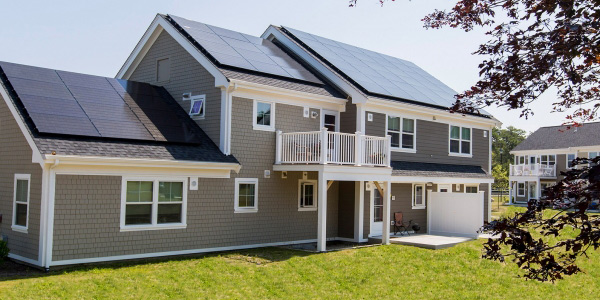Massachusetts’ battery storage program lowered utility costs and reduced battery payback periods for multifamily affordable housing, according to a report by Clean Energy Group (CEG).
ConnectedSolutions, a battery storage program under the state’s energy efficiency initiative Mass Save, uses customer-sited batteries to reduce peak network energy use.
CEG’s analysis found the incentives offered under ConnectedSolutions made solar and battery storage projects a better financial choice for multifamily affordable housing units. Without the incentive program, the renewable energy resource would not be a feasible economic investment for facilities serving these communities, the report said.
The program is accessible to any resident or business interested in participating, but the report analyzed six different affordable housing properties in Massachusetts.
“It is clearly evident from the work here that in multifamily affordable housing in Massachusetts, introduction of the ConnectedSolutions program has been a real advantage to these projects and is improving the finance ability and bankability of installing solar plus storage,” Todd Olinsky-Paul, senior project director at CEG, said during a webinar hosted by the nonprofit.
The ConnectedSolutions program pays customers who discharge stored battery energy to the grid. Customers enter a contract with the utility to participate in the program. They have the option to discharge energy to the grid when the utility needs it to accommodate electricity demand peaks across the network. Payment is based on performance.
Affordable housing properties with solar plus storage, like the Residences at Melpet Farm seen here in Dennis, Mass., are benefiting through participation in a program that supports utilities during peak network demand. | Preservation of Affordable Housing
The program, the report said, offers benefits to multifamily housing units that could not always be achieved by using storage to offset property-specific demand charges.
Participants “are rewarded for their performance during three-hour dispatch windows, achieving greater economic returns by delivering more power for a longer duration than systems optimized for managing onsite demand to reduce utility demand charges, which typically targets much shorter peak periods,” the report said.
The revenue potential of a battery that participates in the program is not limited by the size of the load of the multifamily housing unit at which is it sited. And that revenue potential provides an incentive to install a larger battery than would otherwise be used for demand charge management only.
CEG’s analysis found a 14% reduction in utility bills for the units with ConnectedSolutions, compared to a building that relies solely on demand charge management.
Rates of return on the investment in solar plus storage with ConnectedSolutions improved by 26% for nonprofit affordable housing units and 36% for tax-exempt affordable housing units compared to demand charge management alone.
The payback period, or time it takes to recover the cost of the investment, decreased by 70% with the ConnectedSolutions program for both nonprofit and tax-exempt units, the report said.
And utilities like the program because it allows them to procure storage without having to own the storage, Olinsky-Paul said, adding that “utilities need that load reduction.”
Traditional energy sources used during peak periods emit higher amounts of carbon and are costly to maintain even when they are idle, he said.
Utilities also receive performance incentive payments for running these programs, and participating helps the state reach its climate goals.
Eversource and National Grid have expanded the program to other states they serve, including Connecticut and Rhode Island.
“And these programs are designed to reach overburdened communities, which need efficiency improvements,” Olinsky-Paul said.


